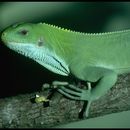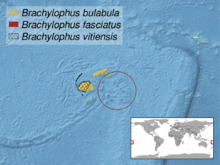fi
nimet breadcrumb-navigoinnissa


Fidschileguane (Brachylophus) sind eine Gattung endemisch auf Fidschi und Tonga lebender Leguane. Sie ähneln dem Grünen Leguan, bleiben mit einer maximalen Länge von einem Meter allerdings deutlich kleiner. Auch die Kämme im Nacken, auf dem Rücken und dem Schwanz und die Kehlwamme werden nicht so groß und imposant wie bei ihrem Verwandten. Der Schwanz erreicht die dreifache Kopf-Rumpf-Länge.
Fidschileguane sind wenig erforschte Waldbewohner und ernähren sich von Blättern. Sie legen drei bis sechs (meist vier) Eier in selbstgegrabenen Höhlen. Die Jungtiere schlüpfen, je nach Temperatur nach 150 bis 200 Tagen.
In der Roten Liste des IUCN wird Brachylophus fasciatus als „stark gefährdet“, Brachylophus vitiensis als „vom Aussterben bedroht“ eingestuft. Brachylophus bulabula wird dort noch nicht als eigene Art berücksichtigt.
Neben den heute lebenden Arten gab es noch größer werdende Formen, deren Knochen bei Ausgrabungen der späten Lapita-Kultur auf der Tongainsel Lifuka gefunden wurden. Die Tiere wurden möglicherweise von den polynesischen Siedlern oder durch die Konkurrenz mit eingeführten Haustieren ausgerottet.[3]
Da die nächsten Verwandten der Fidschileguane ca. 8000 Kilometer entfernt in Südamerika leben, stellt sich die Frage, wie sie auf die Südsee-Inseln der Staaten Fidschi und Tonga gelangt sind. Nach früherer Auffassung sollen sie mit Treibholz von Südamerika in ihren jetzigen Lebensraum gelangt sein, vergleichbar mit der Wanderung anderer Tierarten zu den Galapagosinseln. Demgegenüber vertreten die amerikanischen Forscher Brice P. Noonan und Jack W. Sites, Jr. die These, dass diese Leguane bzw. ihr letzter gemeinsamer Vorfahr schon sehr lange in dieser Weltgegend leben[4]. Mit Hilfe der molekularen Uhr lasse sich erkennen, dass dieser gemeinsame Vorfahr bereits vor 50 bis 60 Millionen Jahren im Bereich der Inseln angekommen sei, zu dieser Zeit standen die späteren Südseeinseln noch mit Teilen von Gondwana in Verbindung, der Vorfahr der Fidschi-Leguane sei also über Landbrücken gewandert und nicht übers Meer gekommen. Er habe auch andere Südseeinseln besiedelt, sei aber von den dort bereits früh eingewanderten Menschen ausgerottet worden.[5]
Fidschileguane (Brachylophus) sind eine Gattung endemisch auf Fidschi und Tonga lebender Leguane. Sie ähneln dem Grünen Leguan, bleiben mit einer maximalen Länge von einem Meter allerdings deutlich kleiner. Auch die Kämme im Nacken, auf dem Rücken und dem Schwanz und die Kehlwamme werden nicht so groß und imposant wie bei ihrem Verwandten. Der Schwanz erreicht die dreifache Kopf-Rumpf-Länge.
Fidschileguane sind wenig erforschte Waldbewohner und ernähren sich von Blättern. Sie legen drei bis sechs (meist vier) Eier in selbstgegrabenen Höhlen. Die Jungtiere schlüpfen, je nach Temperatur nach 150 bis 200 Tagen.
Kurzkammleguan (Brachylophus fasciatus (Brongniart, 1800)) – lebt auf Fidschi und Tonga und wurde auf Vanuatu eingeführt Brachylophus bulabula Fisher, Harlow, Edwards & Keogh, 2008 Brachylophus gau Fisher, Niukula, Watling & Harlow, 2017 – kommt endemisch in den Wälder im Innern der Insel Gau vor Brachylophus vitiensis Gibbons, 1981 – kommt nur noch auf der kleineren Fidschiinsel Yaduataba mit ca. 4000 bis 6000 Exemplaren vorIn der Roten Liste des IUCN wird Brachylophus fasciatus als „stark gefährdet“, Brachylophus vitiensis als „vom Aussterben bedroht“ eingestuft. Brachylophus bulabula wird dort noch nicht als eigene Art berücksichtigt.
Neben den heute lebenden Arten gab es noch größer werdende Formen, deren Knochen bei Ausgrabungen der späten Lapita-Kultur auf der Tongainsel Lifuka gefunden wurden. Die Tiere wurden möglicherweise von den polynesischen Siedlern oder durch die Konkurrenz mit eingeführten Haustieren ausgerottet.
The genus Brachylophus consists of four extant iguanid species native to the islands of Fiji[1] and a giant extinct species from Tonga in the South West Pacific.[2] One of the extant species, B. fasciatus, is also present on Tonga, where it has apparently been introduced by humans.[2]
The name, Brachylophus, is derived from two Greek words: brachys (βραχύς) meaning "short" and lophos (λόφος) meaning "crest" or "plume", denoting the short spiny crests found along the backs of these species.
Brachylophus species are the most geographically isolated iguanas in the world. Their closest extant relatives (the genera Amblyrhynchus, Conolophus, Ctenosaura, Cyclura, Iguana and Sauromalus[2]) are present in primarily tropical regions of the Americas and islands in the Galápagos and Lesser and Greater Antilles. Several of these genera are adapted to xeric biomes. Phylogenetic evidence supports the Brachylophus lineage to have diverged from the rest of Iguanidae in the latest Eocene, about 35 million years ago. They are the second most basal extant genus in the family, with only Dipsosaurus diverging earlier.[3] The location of members of Brachylophus, so distant from all other known extant or extinct iguanids, has long presented a biogeographical enigma.
One hypothesis to account for this biogeographical puzzle, based in part on an estimated divergence date of 50 million years ago (although more recent studies have revised this to about 35 million years ago[3]), is that these species are the descendants of a more widespread but now extinct lineage of Old World iguanids that migrated overland from the New World to Asia or Australia, and then dispersed by some combination of continental drift, rafting and/or land bridges to their present remote location.[4] However, no other fossil or extant species of this putative lineage have been found to date in Southeast Asia, Australasia or the western Pacific outside of Fiji and Tonga.[4]
A secondary hypothesis, and the more widely accepted one, is that these species evolved from New World iguanas that rafted 10,000 km (6,200 mi) west across the Pacific Ocean with the aid of the South Equatorial Current.[5][6] While a rafting voyage of four months or more might seem implausible, the ancestors of Brachylophus may have been preadapted for such a journey by having water requirements that can be satisfied by food alone, as well as comparatively long egg incubation periods.[6]
Historically, only the first two were recognized, but B. bulabula ("bulabula" is the Fijian word for "healthy" or "flourishing") was described in the central regions of Fiji by a team led by a scientist from the Australian National University in 2008. Detailed genetic and morphological analyses were made to conclude that B. bulabula represents a third species.[2][8] In 2017, B. gau was described as a new species from Gau Island.[1][9]
A giant Tongan species, Brachylophus gibbonsi, similar in size and build to an iguana of the genus Cyclura once existed on Lifuka, islands in the Ha‘apai group and Tongatapu but became extinct in prehistoric times due to predation by humans and their domestic animals.[2][10][11] An even larger extinct iguana of the separate genus Lapitiguana was formerly present on Fiji.[12]
The genus Brachylophus consists of four extant iguanid species native to the islands of Fiji and a giant extinct species from Tonga in the South West Pacific. One of the extant species, B. fasciatus, is also present on Tonga, where it has apparently been introduced by humans.
Brachylophus es un género de iguánidos de la familia Iguanidae.
Son endémicas de las islas Fiyi y Tonga, aunque las de estas últimas islas están extintas desde la prehistoria.
Se reconocen las siguientes:[1]
Brachylophus es un género de iguánidos de la familia Iguanidae.
Son endémicas de las islas Fiyi y Tonga, aunque las de estas últimas islas están extintas desde la prehistoria.
Brachylophus Iguanidae familiako genero bat da. Ozeanian aurki daitezke, ziurenik Hego Amerikatik dauden 8.000 kilometroak gaindituz.
Brachylophus Iguanidae familiako genero bat da. Ozeanian aurki daitezke, ziurenik Hego Amerikatik dauden 8.000 kilometroak gaindituz.
Brachylophus est un genre de sauriens de la famille des Iguanidae[1].
Les espèces de ce genre se rencontrent en Océanie[1].
Les espèces de ce genre ont un corps assez massif, avec une longue queue et de grandes rayures. Les couleurs vont du blanc au vert sombre. Ces reptiles sont diurnes et plutôt arboricoles.
Ils pourraient descendre d'iguanes partis à la dérive sur plus de 8 000 km depuis l'Amérique centrale ou l'Amérique du Sud[2]. Une autre théorie implique la dispersion via une supposée lignée d'iguanes, qui serait désormais éteinte, ayant vécu en Australie ou en Asie[3].
Selon Reptarium Reptile Database (9 novembre 2017)[4] :
Båndiguaner er en slekt øgler som kun finnes på øygruppene Fiji og Tonga i Stillehavet. De nærmeste slektningene lever i Sør-Amerika i en avstand på over 8000 km.
De ligner på grønn iguan, men totallengden er maksimalt en meter. Ryggkammen er mindre enn hos slektningene. Alle artene er grønne med tverrbånd i en annen farge. Båndiguaner lever i skog. Ungene eter insekter, men de voksne er rene planteetere, som lever av blader, frukt og blomster.
En har trodd at båndiguanene stammer fra iguaner som er blitt transportert på flytende vegetasjon fra Sør-Amerika. Ifølge en ny teori har båndiguanene kommet fra Asia eller Australia. Boaslanger er kommet til øyene på samme måte. Grunnen til at det nå ikke finnes iguaner på øyene lenger vest, er at disse øyene ble kolonisert mye tidligere av mennesker, som jaktet på, og utryddet iguanene.[1]
Før mennesker spredte seg utover i Stillehavet fantes det kjempeiguaner både på Fiji (Lapitiguana impensa)[2] og Tonga (Brachylophus gibbonsi).[3] Fiji hadde en megafauna med mange storvokste arter, blant annet duer, ovnhøns, en frosk, og en landlevende krokodille.[4]
Tre nålevende arter er kjent:
Båndiguaner er en slekt øgler som kun finnes på øygruppene Fiji og Tonga i Stillehavet. De nærmeste slektningene lever i Sør-Amerika i en avstand på over 8000 km.
De ligner på grønn iguan, men totallengden er maksimalt en meter. Ryggkammen er mindre enn hos slektningene. Alle artene er grønne med tverrbånd i en annen farge. Båndiguaner lever i skog. Ungene eter insekter, men de voksne er rene planteetere, som lever av blader, frukt og blomster.
En har trodd at båndiguanene stammer fra iguaner som er blitt transportert på flytende vegetasjon fra Sør-Amerika. Ifølge en ny teori har båndiguanene kommet fra Asia eller Australia. Boaslanger er kommet til øyene på samme måte. Grunnen til at det nå ikke finnes iguaner på øyene lenger vest, er at disse øyene ble kolonisert mye tidligere av mennesker, som jaktet på, og utryddet iguanene.
Før mennesker spredte seg utover i Stillehavet fantes det kjempeiguaner både på Fiji (Lapitiguana impensa) og Tonga (Brachylophus gibbonsi). Fiji hadde en megafauna med mange storvokste arter, blant annet duer, ovnhøns, en frosk, og en landlevende krokodille.
Brachylophus – rodzaj jaszczurki z rodziny legwanowatych (Iguanidae).
Rodzaj obejmuje gatunki występujące na wyspach Fidżi i Tonga w Oceanii[3].
Brachylophus: gr. βραχυς brakhus „krótki”; λοφος lophos „grzebień, pióropusz”[4]; w aluzji do krótkich, kolczastych czubków umiejscowionych wzdłuż grzbietu tych zwierząt.
Do rodzaju należą następujące gatunki[3]:
a także wymarły gatunek:
Brachylophus – rodzaj jaszczurki z rodziny legwanowatych (Iguanidae).
Brachylophus é um gênero de lagartos da família Iguanidae nativos da ilha Fiji, no Oceano Pacífico. O gênero compreende três espécies:[1]
Brachylophus é um gênero de lagartos da família Iguanidae nativos da ilha Fiji, no Oceano Pacífico. O gênero compreende três espécies:
Brachylophus bulabula Brachylophus fasciatus Brachylophus vitiensisBrachylophus là một chi thằn lằn gồm 3 loài cự đà còn sinh tồn, bản địa của các đảo thuộc Fiji và một loài khổng lồ tuyệt chủng ở Tonga. Một trong ba loài sinh tồn hiện cũng có mặt ở Tonga, nơi nó được con người du nhập đến.[1]
|coauthors= bị phản đối (trợ giúp)
Brachylophus là một chi thằn lằn gồm 3 loài cự đà còn sinh tồn, bản địa của các đảo thuộc Fiji và một loài khổng lồ tuyệt chủng ở Tonga. Một trong ba loài sinh tồn hiện cũng có mặt ở Tonga, nơi nó được con người du nhập đến.

低冠蜥屬(Brachylophus),又名斐濟鬣蜥屬,是南太平洋斐濟及湯加特有的一屬蜥蜴。
低冠蜥屬的冠很短,由冠沿背部長滿棘。牠們與世界上其他的美洲鬣蜥科分隔開來。相信牠們是演化自於1300萬年前由南美洲跨越太平洋到來的綠鬣蜥。[1]現存的物種如下:
另外,在湯加的利夫卡島及湯加塔布市發現了一種史前但已滅絕的巨型低冠蜥屬,其體型有如岩鬣蜥屬,估計是被人類及所馴養的動物迫害而消失。[3]
|accessdate=需要含有|url= (帮助) |accessdate=需要含有|url= (帮助) 
フィジーイグアナ属(フィジーイグアナぞく, Brachylophus)は、爬虫綱有鱗目イグアナ科に属する属。南太平洋のフィジー諸島・トンガ諸島に分布しており、次の二種から構成される[1](先史時代に、おそらくは人間や家畜におされたために絶滅してしまった種が少なくともトンガのリフカ島およびトンガタプ島に存在した)[2]。
2008年9月、オーストラリア国立大学の自然科学者らが率いるチームによって第三の種 Brachylophus bulabula がフィジーの中央部で発見された[3]。学名の後半部分(種小名) bulabula (ブラブラ)は、フィジー語の bula (こんにちは)に因む命名。遺伝学的、形態学的な分析が詳細に行われ、第三の種であるとの結論が下された[4]。
フィジーイグアナ属(フィジーイグアナぞく, Brachylophus)は、爬虫綱有鱗目イグアナ科に属する属。南太平洋のフィジー諸島・トンガ諸島に分布しており、次の二種から構成される(先史時代に、おそらくは人間や家畜におされたために絶滅してしまった種が少なくともトンガのリフカ島およびトンガタプ島に存在した)。
ヒロオビフィジーイグアナ (Brachylophus fasciatus) タテガミフィジーイグアナ (Brachylophus vitiensis)2008年9月、オーストラリア国立大学の自然科学者らが率いるチームによって第三の種 Brachylophus bulabula がフィジーの中央部で発見された。学名の後半部分(種小名) bulabula (ブラブラ)は、フィジー語の bula (こんにちは)に因む命名。遺伝学的、形態学的な分析が詳細に行われ、第三の種であるとの結論が下された。